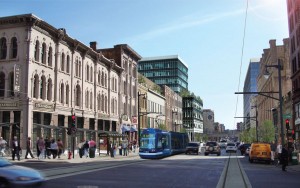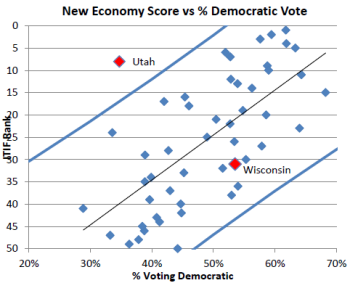Why Utah Scores High on New Economy Rankings
Yes, it’s conservative, but it strongly supports rail transit and urban living. Final story of a series.
While there are many possible factors influencing whether a metro area fosters innovation and high-tech startups, experts have pointed to two key ones: a tolerance for odd ideas and a lifestyle/ambience attractive to “nerds” and investors, who typically favor trendy urban areas. Typically the nation’s more liberal areas are more likely to tolerate odd ideas, as I’ve previously written.
As you can see in this chart, states voting Democratic tend to score higher on the Information Technology and Innovation Foundation’s New Economy Index, lending support to the idea that liberal-leaning areas might create an environment more conducive to innovation. But note two exceptions in red: Utah votes heavily Republican yet scores very high on the new economy index and Wisconsin leans Democratic yet has relatively poor scores on the index.
In my second article in this series, I’ve suggested this state’s liberal base hasn’t been all that tolerant to new ideas, citing its opposition to school reform, and has also shown an antipathy towards profit-making enterprises that undercut efforts to build a new economy.
Of course, the conservative groups pushing for ideological conformity are active throughout the United States. For example, one of the most active, the Koch-supported Americans for Prosperity, claims chapters in 38 states. Yet it is possible to resist the anti-urban philosophy of today’s conservatives, as Utah has proven.
By most measures, the state is extremely conservative. As to presidential voting, Utah competes with Oklahoma, Idaho, Wyoming, and West Virginia as the state most favorable to Republican candidates. (To eliminate the skewing effect of the 2012 election, when Mitt Romney, a Mormon, was the candidate, I substituted the 2008 voting results for Utah; otherwise, the Democratic vote would have been even lower for Utah.) Several years ago Utah’s conservative senator was ousted by a more conservative candidate. And on a variety of social issues, Utah ends up in the conservative camp.
|
High-Tech Startup Density |
||
|
1990 |
2010 |
|
|
Milwaukee-Waukesha-West Allis, WI |
1.0 |
0.6 |
|
Madison, WI |
1.4 |
1.0 |
|
Salt Lake City, UT |
1.6 |
2.0 |
|
Provo-Orem, UT |
1.4 |
1.9 |
Yet the state scores well on the New Economy index. It is well beyond the 95 percent prediction limit that allows it to qualify as an outlier on the above chart. And it has consistently ranked high for encouraging technology and innovation. In the twenty years between 1990 and 2010, Salt Lake City and Provo increased their score for high-tech start-up density while Milwaukee and Madison declined.
What explains Utah’s role as an outlier? One possible explanation is that Mormons are abnormally entrepreneurial. For instance, the expectation that its young members spend a year or two trying to convert skeptical audiences would be excellent preparation for success in businesses.
Or perhaps Utah’s conservatives are a more pragmatic bunch than conservatives in other states. Supporting this thesis is Utah voters’ willingness to embrace rail transportation as part of the states’ transportation strategy.

A rendering of the streetcar coming up Broadway out of the Historic Third Ward.
In recent years, a unifying theme among Wisconsin conservatives has been opposition to any public transportation that uses rails. This opposition has been very effective, killing light rail proposals for the Milwaukee area, killing the proposed commuter line between Milwaukee and Kenosha which would have connected to Chicago, and giving up a federal grant of more than $800 million for a rail line from Milwaukee and Madison. Now conservatives seem intent upon placing obstacles before Milwaukee’s streetcar proposal.
On most any conservative website in Wisconsin you can find articles attacking rail transportation. Often these are reworked versions of articles used to oppose light rail or streetcar proposals in other states. Two particularly prolific authors are Randal O’Toole of the Cato Institute and Wendall Cox of the Heartland Institute, who have made a cottage industry of opposing such proposals wherever they arise. The details of the arguments are not always consistent but the conclusions are: rail transport is a bad idea. For example one article argues that Milwaukee lacks the conditions that made the Portland streetcar a success while another argues that Portland’s streetcar was a fiasco.
Given the almost universal opposition to rail transportation from this array of conservative organizations, amplified by Milwaukee talk radio, Wisconsinites might expect that Utah’s conservatism would be the last place where rail transportation could take hold. Yet that perception would be wrong.
Over a period of seven years, Salt Lake City and its environs added 70 miles of tracks on five light rail and commuter rail lines. Transit riders have responded. According to the latest survey by the American Public Transportation Association, ridership on its three modes (buses, light rail, and commuter rail) approximates the total ridership on Milwaukee buses, even though Milwaukee’s population is substantially larger than Salt Lake City’s, whether measured by the city or the metropolitan area. Commuter rail ridership rose 103 percent and light rail rose nearly 7 percent in the last year.
|
Population |
|||||||
| Salt Lake City | Average weekday |
2012 |
2013 |
% Change | City | Metro | |
| Commuter rail |
14,700 |
1,869.7 |
3,800.4 |
103% |
189,314 |
1,123,712 |
|
| Light rail |
68,100 |
17,551.8 |
18,740.6 |
6.77% |
|||
| Bus |
72,200 |
21,222.8 |
19,444.8 |
-8.38% |
|||
|
155,000 |
40,644.3 |
41,985.8 |
3.30% |
||||
| Milwaukee | Bus |
141,900 |
44,049.50 |
43,008.80 |
-2.36% |
598,916 |
1,566,981 |
Back in the 1990s, voters in Salt Lake City rejected a measure to fund light rail but little more than a decade later they embraced transit. Why? Clearly there were conservatives pushing the idea. Perhaps Utah’s conservatism is a throwback to the past— the old style conservatism that backed infrastructure improvements all all kinds and which was far more pragmatic than the version that has now come to dominate in Wisconsin and most other states. Whatever the reason, Salt Lake City has been allowed to become more urban, and that is likely to help it attract the kind of entrepreneurs and innovators that are needed to build a new economy.
Data Wonk
-
Scott Walker’s Misleading Use of Job Data
 Apr 3rd, 2024 by Bruce Thompson
Apr 3rd, 2024 by Bruce Thompson
-
How Partisan Divide on Education Hurts State
 Mar 27th, 2024 by Bruce Thompson
Mar 27th, 2024 by Bruce Thompson
-
Will Wisconsin Supreme Court Legalize Absentee Ballot Boxes?
 Mar 20th, 2024 by Bruce Thompson
Mar 20th, 2024 by Bruce Thompson

















Excellent piece and series. I might add that Salt Lake City has a population density of 1,678 per square mile compared to Milwaukee at 6,188. Population density is one of the best measures of possible success of urban rail transit. Rail transit is flourishing in Salt Lake City despite a population density almost 4 times less than Milwaukee. In fact it is flourishing in many cities with less population density than Milwaukee.
John Norquist once commented that Salt Lake City is so conservative that it did not need talk radio.
Great article! One thing that may sway coservative types in Wisconsin toward more public transit projects, if not the increase in economic activity as evidenced in Salt Lake and elsewhere, is the increase in property values when there is a transit stop nearby. There are plenty of suburban (and generally conservative) owners of property in Milwaukee who I bet would like to see the low values of their holdings go up again.
“Salt Lake City has been allowed to become more urban, and that is likely to help it attract the kind of entrepreneurs and innovators that are needed to build a new economy.”
Perhaps if Walker hadn’t flushed $800 milliion away, he would have had a better chance at fullfiling his promise of creating 250,000 new jobs.
Bruce, what’s missing in this is the effect of race on transportation decisions by Wisconsin versus Utah. What is the minority population of Utah compared to Wisconsin’s? i think we need examine the racial bias issue in regard to transportation issues in Wisconsin as the greatest concentration of African Americans and Latinos are in Milwaukee-Racine-Kenosha and Madison. To me that is always an underlying theme in the anti-rail rants and I’m an old white guy who lives in the Bay!
Just to clarify, Salt Lake City’s metro area is made up of 3 separate but connected metropolitan areas (Salt Lake City, Provo & Ogden) all of which share the same mass transit system. The population of greater Salt Lake is close to 2.5MM and is among the fastest growing areas in the country.
On Ryan’s point, in the original draft I tried to compare transportation usage with population. I took that out because it was unclear what population was most appropriate for Salt Lake City.
The broader point is that Utah seems to be a throwback to an earlier era, where one could be a conservative without adopting all the tenants of the party line. For example there were ardent conservative politicians who were also committed environmentalists. For what it is worth, Utah is one of the few states without a chapter of Americans for Prosperity and also places abnormally high for a red state on the American Bike Federation’s list of bike-friendly states.
Mormons are required to spend 18-24 months as “missionaries” (trying to convert others to Mormonism), often in another country. (Mitt Romney was a missionary in France, for example.)
Although I’m not a Mormon, I think this makes Mormons more worldly, less provincial, and less afraid of people who happen to be different. They see how transit works in other places and bring those ideas home with them.
They are also much more likely to speak a second language (picked up as a missionary) which makes Salt Lake City more inviting for foreign businesses and entrepreneurs.
One commentator suggested that race plays a factor in the debate about transit. The 2010 stats for Salt Lake City: 75%-white; 2.7%-African American; 4.4%-Asian; 22.3%-Hispanic. The 2010 Stats for Milwaukee: 44.8%-white; 40%-African American; 3.5%-Asian; 17.3%-Hispanic. Perhaps the commentator is on to something.
Is there an argument to be made for more clearly defining “conservative”? I know a couple of Mormon families and they’re socially conservative within their own beliefs, but they have never belittled my beliefs or tried to force their beliefs on me. Similarly, is it possible to be socially conservative, and fiscally progressive? Look at the Romney governorship – by all accounts, Romney invented Obamacare.
Or is it possible that Utah citizens realize they need to compete with more liberal areas like California, Las Vegas, and Colorado and therefore they’re more tolerant of “liberal” ideas.
I do believe the throwback idea has some merit to it. After all, most Americans (conservative and liberal) rode rail transit in and in between cities up to the 50s. SLC is the only city where I’ve seen average people on the street dressing as though we were still in that era. Kind of timeless paradise they have there, values and all.
As for why WI conservatives seem to hate rail, there is probably a subconscious discrimination against those who would be taking public transit most (ie minorities and city dwellers). Perhaps there is a fear that said elements would take transit out of the city, or perhaps these car-driving conservatives simply don’t want to pay for public transit services.
Either way, ignored remains the fact that as the economy changes, rail becomes increasingly a beneficial investment. Especially for transport of goods.